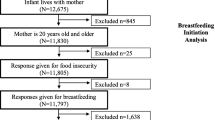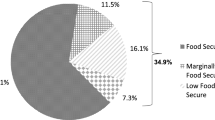Abstract
The objective of this study is to explore the association between having a child with special health care needs (CSHCN) and food insecurity when the child is 2 years old. We studied women who had a live birth in 2004–2005 and responded to Oregon’s Pregnancy Risk Assessment Monitoring System (PRAMS) survey 3 months postpartum (Time 1) and the follow-up survey (PRAMS-2), when the child was 2 years old (Time 2). Women answering affirmatively to the PRAMS-2 question, “In the last 12 months, did you ever eat less than you felt you should because there was not enough money for food?” were considered food insecure. CSHCN status was identified by affirmative responses to questions about needs for ongoing services (Time 2). PRAMS and PRAMS-2 responses were weighted for study design and non-response. Results report weighted analyses, unless noted. Among 1812 mothers completing PRAMS-2, 13.6 % (unweighted) had a 2-year-old CSHCN and 11.9 % (unweighted) were food insecure at Time 2. The estimated prevalence of food insecurity at 2-year follow-up was 20.7 % among families of CSHCN and 9.7 % for others. After adjustment for Time 2 marital status, education, lifetime U.S. residence, income and health conditions, multivariable logistic regression revealed that odds of food insecurity were more than two times as great for CSHCN mothers 2 years post-partum compared to non-CSHCN mothers (adjusted odds ratio 2.6, 95 % confidence interval 1.3, 4.6). Families of CSHCN face increased risk for food insecurity. Improved understanding of causal determinants of food insecurity among households of CSHCN is needed.
Similar content being viewed by others
References
Anderson, S. (1990). Core indicators of nutritional state for difficult-to-sample populations. The Journal of Nutrition, 120(Suppl 11), 1559–1600.
Healthy People 2020, Nutrition and weight status, healthier food access, (n.d.). Retrieved January 18, 2015, from http://www.healthypeople.gov/2020/topics-objectives/topic/nutrition-and-weight-status.
Lee, J. S., Gundersen, C., Cook, J., Laraia, B., & Johnson, M. A. (2012). Food insecurity and health across the lifespan. Advances in Nutrition, 3(5), 744–745. doi:10.3945/an.112.002543.
Food and Agriculture Organization and United Nations, The State of Food Insecurity in the World 2014. Retrieved January 18, 2015, from http://www.fao.org/publications/sofi/2014/en/.
Coleman-Jensen, A., Nord, M., & Singh, A. (2013). Household food security in the United States in 2012. US Department of Agriculture, Economic Research Service, Washington, DC. Retrieved from http://www.ers.usda.gov/media/1183208/err-155.pdf.
Nord, M., Coleman-Jensen, A., Andrews, M., & Carlson, S. (2009). Household food security in the United States, 2008. US Department of Agriculture, Economic Research Service, Washington, DC. Retrieved December 12, 2014, from http://www.ers.usda.gov/media/122550/err108_1_.pdf.
Gunderson, C., Waxman, E., Engelhard, E., & Brown, J. (n.d.). Map the meal gap child food insecurity 2011. Retrieved April 1, 2012, from: http://feedingamerica.org/hunger-in-america/hunger-studies/map-the-meal-gap/map-executive-summary-child.aspx.
Melchior, M., Chastang, J.-F., et al. (2012). Food insecurity and children’s mental health: A prospective birth cohort study. PLoS ONE, 7(12), e52615. doi:10.1371/journal.pone.0052615.
Carter, M. A., Dubois, L., Tremblay, M. S., & Taljaard, M. (2012). Local social environmental factors are associated with household food insecurity in a longitudinal study of children. BMC Public Health, 12, 1038. doi:10.1186/1471-2458-12-1038.
Marjerrison, S., Cummings, E. A., Glanville, N. T., Kirk, S. F. L., & Ledwell, M. (2011). Prevalence and associations of food insecurity in children with diabetes mellitus. The Journal of Pediatrics, 158(4), 607–611. doi:10.1016/j.jpeds.2010.10.003.
McDonald, C. M., Christensen, N. K., Lingard, C., Peet, K. A., & Walker, S. (2009). Nutrition knowledge and confidence levels of parents of children with cystic fibrosis. ICAN: Infant, Child, & Adolescent Nutrition, 1(6), 325–331. doi:10.1177/1941406409355192.
Cook, J. T., Frank, D. A., Berkowitz, C., et al. (2004). Food insecurity is associated with adverse health outcomes among human infants and toddlers. The Journal of Nutrition, 134(6), 1432–1438.
Alaimo, K., Olson, C. M., Frongillo, E. A., & Briefel, R. R. (2001). Food insufficiency, family income, and health in US preschool and school-aged children. American Journal of Public Health, 91(5), 781–786.
Jyotti, D. F., Frongillo, E. A., & Jones, S. J. (2005). Food insecurity affects school children’s academic performance, weight gain, and social skills. The Journal of Nutrition, 135(12), 2831–2839.
Cunningham, T. J., Barradas, D. T., Rosenberg, K. D., May, A. L., Kroelinger, C. D., & Ahluwalia, I. B. (2012). Is maternal food security a predictor of food and drink intake among toddlers in Oregon? Maternal and Child Health Journal, 16(Suppl 2), 339–346. doi:10.1007/s10995-012-1094-8.
Rosas, L. G., Harley, K., Fernald, L. C., et al. (2012). Dietary associations of household food insecurity among children of Mexican descent: results of a binational study. Journal of the American Dietetic Association, 109(12), 2001–2009. doi:10.1016/j.jada.2009.09.004.
Slopen, N., Fitzmaurice, G., Williams, D. R., & Gilman, S. E. (2010). Poverty, food insecurity, and the behavior of childhood internalizing and externalizing disorders. Journal of the American Academy of Child and Adolescent Psychiatry, 49, 444–452.
Ryu, J.-H., & Bartfeld, J. S. (2012). Household food insecurity during childhood and subsequent health status: the early childhood longitudinal study—Kindergarten cohort. American Journal of Public Health, 102(11), e50–e55. doi:10.2105/AJPH.2012.300971.
Zaslow, M., Bronte-Tinkew, J., Capps, R., Horowitz, A., Moore, K. A., & Weinstein, D. (2008). Food security during infancy: Implications for attachment and mental proficiency in toddlerhood. Maternal and Child Health Journal, 13, 66–80. doi:10.1007/s10995-008-0329-1.
McPherson, M., Arango, P., et al. (1998). A new definition of children with special health care needs. Pediatrics, 102(1), 137–139.
CSHCN screener—(Children with Special Health Care Needs (CSHCN) Screener, the Child and Health Measurement Initiative. Retrieved December 27, 2014, from http://www.cahmi.org/projects/children-with-special-health-care-needs-screener/.
National Survey of Children with Special Health Care Needs 2005–2006: Oregon CSHCN Data. (2011). Retrieved December 6, 2011, from http://mchb.hrsa.gov/cshcn05/SD/oregon.htm.
Van Dyck, P. C., Kogan, M. D., McPherson, M. G., Weissman, G. R., & Newacheck, P. W. (2004). Prevalence and characteristics of children with special health care needs. Archives of Pediatric Adolescent Medicine, 158(9), 884–890. doi:10.1001/archpedi.158.9.884.
Kuhlthau, K., Hill, K. S., Yucel, R., & Perrin, J. M. (2005). Financial burden for families of children with special health care needs. Maternal and Child Health Journal, 9, 207–218. doi:10.1007/s10995-005-4870-x.
Bumbalo, J., Ustinich, L., Ramcharran, D., & Schwalberg, R. (2005). Economic impact on families caring for children with special health care needs in New Hampshire: The effect of socioeconomic and health-related factors. Maternal and Child Health Journal, 9, S3–S11. doi:10.1007/s10995-005-4350-3.
Viner-Brown, S. I., & Kim, H. K. (2005). Impact of caring for children with special health care needs on the family: Rhode Island’s experience. Maternal and Child Health Journal, 9, S59–S66. doi:10.1007/s10995-005-4483-4.
Porterfield, S. L., & DeRigne, L. (2011). Medical home and out-of-pocket medical costs for children with special health care needs. Pediatrics, 128(5), 892–900. doi:10.1542/peds.2010-1307.
CDC—Methodology—Pregnancy Risk Assessment Monitoring System—Reproductive Health. (n.d.). Retrieved February 18, 2013, from http://www.cdc.gov/prams/methodology.htm.
Oregon PRAMS (Pregnancy Risk Assessment Monitoring System). Retrieved November 30, 2011, from http://public.health.oregon.gov/HealthyPeopleFamilies/DataReports/prams/Pages/index.aspx.
Hosmer, D. W., & Lemeshow, S. (2013). Applied logistic regression. Oxford: Wiley-Blackwell.
StataCorp. (2009). Stata statistical software: Release 11. College Station, TX: StataCorp LP.
Bethell, C. D., Reed, D., Stein, R. E., Blumberg, S. J., Wells, N., & Newacheck, P. W. (2002). Identifying children with special health care needs: development and evaluation of a short screening instrument. Ambulatory Pediatrics, 2(1), 38–48.
Hoisington, A. T., Braverman, M. T., Hargunani, D. E., Adams, E. J., & Alto, C. L. (2012). Health care providers’ attention to food insecurity in households with children. Preventive Medicine. doi:10.1016/j.ypmed.2012.06.007.
Hager, E. R., Quigg, A. M., Black, M. M., et al. (2010). Development and validity of a 2-item screen to identify families at risk for food insecurity. Pediatrics, 126(1), e26–e32. doi:10.1542/peds.2009-3146.
Yu, H., Dick, A. W., & Szilagyi, P. G. (2008). Does public insurance provide better financial protection against rising health care costs for families of children with special health care needs? Medical Care, 46, 1064–1070. doi:10.1097/MLR.0b013e318185cdf2.
Thyen, U., Kuhlthau, K., & Perrin, J. M. (1999). Employment, child care, and mental health of mothers caring for children assisted by technology. Pediatrics, 103(6), 1235–1242.
Association of Maternal and Child Health Programs, Innovation Station. Alaska Childhood Understanding Behavior Survey (CUBS). Retrieved January 9, 2015, from http://www.amchp.org/programsandtopics/BestPractices/InnovationStation/ISDocs/AK-CUBS.pdf.
Rosenberg, K. D., Hembroff, L., Drisko, J., Viner-Brown, S., Decker, K., & Lichter, E. (2011). New options for maternal and child health surveillance by state health departments. Maternal and Child Health Journal, 15(3), 302–309. doi:10.1007/s10995-010-0589-4.
Oklahoma State Department of Health, Maternal and Child Health. The Oklahoma Toddlers Survey (TOTS). Retrieved January 18, 2015, from http://www.ok.gov/health/Child_and_Family_Health/Maternal_and_Child_Health_Service/Data_and_Evaluation/The_Oklahoma_Toddler_Survey_(TOTS)/index.html.
Jones, A. D., Ngure, F. M., Pelto, G., & Young, S. L. (2013). What are we assessing when we measure food security? A compendium and review of current metrics. Advances in Nutrition, 4(5), 481–505. doi:10.3945/an.113.004119.
Acknowledgments
We would like to acknowledge PRAMS and PRAMS-2 participants as well as Al Sandoval for providing technical assistance related to use of PRAMS and PRAMS-2 data and Tina Kent and Caitlyn Howell for their work in data collection. This work would not have been possible without their contributions. Funding for the PRAMS and PRAMS-2 surveys comes from the Oregon Health Authority; Oregon Office of Children and Youth with Special Health Needs (at Oregon Health & Science University); the Centers for Disease Control and Prevention (US Department of Health and Human Services (HHS)); and the Maternal and Child Health Bureau (Health Resources and Services Administration, HHS).
Author information
Authors and Affiliations
Corresponding author
Rights and permissions
About this article
Cite this article
Adams, E.J., Hoffmann, L.M., Rosenberg, K.D. et al. Increased Food Insecurity Among Mothers of 2 Year Olds with Special Health Care Needs. Matern Child Health J 19, 2206–2214 (2015). https://doi.org/10.1007/s10995-015-1735-9
Published:
Issue Date:
DOI: https://doi.org/10.1007/s10995-015-1735-9




